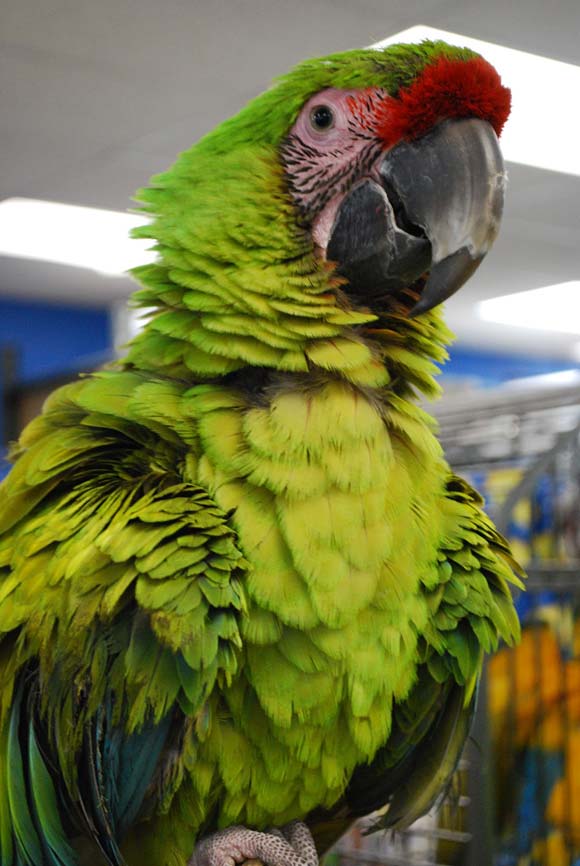
Parrots are fascinating and intelligent creatures, known for their vibrant personalities and playful antics.
However, their excitement can sometimes turn into aggression, posing challenges for parrot owners and trainers.
In this comprehensive guide, we explore the phenomenon of parrot excitement leading to aggression, drawing insights from Barbara Heidenreich’s experiences and expertise in parrot training.
Understanding Parrot Excitement and Aggression
The Charismatic Macaws: Willie and Nico
At a recent parrot training seminar, Barbara Heidenreich had the opportunity to work with two remarkable macaws. One was a Buffon’s Macaw named Willie, who weighed about 1400 grams, making him larger than some Hyacinth Macaws.
The other was a Green-winged Macaw named Nico. Both birds displayed a strong desire to make “googly eyes” at Barbara, demonstrating a common behavior among macaws that involves eye contact, facial flushing, and head movements, often accompanied by cute vocalizations.
The Problem with Parrot Excitement
While these behaviors are endearing and often elicit excited reactions from parrot lovers, they can lead to heightened levels of arousal in the parrot.
This excitement can easily flip to aggressive behavior, especially if the parrot feels overstimulated or if there is a sudden change in the interaction.
This becomes particularly problematic during training sessions or when handling the bird, as the risk of aggression increases.
Managing Parrot Excitement and Aggression
Strategies to Mitigate Aggression
To manage parrot excitement and prevent it from turning into aggression, Barbara Heidenreich employs several strategies:
Minimize Verbal Interaction: Talking can increase a parrot’s excitement. Therefore, Barbara becomes the quietest trainer she can be, avoiding verbal bridges and delivering reinforcers quickly and quietly.
Avoid Direct Eye Contact: Direct eye contact can encourage more aroused behavior. Instead, Barbara looks towards the parrot’s feet, allowing her to monitor the bird’s beak and overall demeanor without intensifying excitement.
Step Away When Necessary: If the parrot exhibits highly aroused behavior, Barbara steps away to give the bird a chance to settle down before restarting the session.
Success with Willie and Nico
These strategies proved effective with both Willie and Nico.
Barbara observed more calm behavior during their training sessions, and Willie even learned to overcome his fear of her hand, stepping up a few times.
However, the excitement of being on Barbara’s hand was still a challenge, requiring very short sessions to prevent nipping.
With continued training, Willie could learn to remain calm for longer periods while on the hand.
Snowball the Dancing Cockatoo
Snowball, a dancing cockatoo known for his viral dance videos, was also present at the seminar. His caregiver, Irena Schulz of Bird Lovers Only Parrot Rescue, confirmed that allowing Snowball to calm down after dancing sessions before asking him to step up helped prevent aggressive behavior.
Similar to the macaws, interacting with Snowball when he was overly excited could lead to aggression.
Best Practices for Parrot Training and Interaction
Recognizing Individual Differences
Each parrot has a unique personality and tolerance level for excitement. Understanding your parrot’s individual triggers and thresholds for excitement and aggression is crucial.
Some parrots may handle excitement better than others, and what works for one bird may not work for another.
Using Excitement as a Reinforcer
Exciting activities like dancing or playing can be powerful reinforcers for behaviors that do not require direct handling.
However, it is essential to be cautious when transitioning from these activities to training or handling sessions.
Ensuring your parrot has calmed down before expecting focused behavior can prevent aggression.
Creating a Calm Training Environment
A calm and controlled training environment is key to successful parrot training.
Minimize distractions and overstimulation to help your parrot focus on learning new behaviors. Consistent routines and clear signals can also aid in maintaining a calm atmosphere.
The Role of Positive Reinforcement
Building Trust and Reducing Fear
Positive reinforcement is a cornerstone of effective parrot training.
By rewarding desired behaviors with treats, praise, or favorite activities, you can build trust and reduce fear in your parrot. This approach encourages voluntary participation in training and handling.
Gradual Desensitization
Gradual desensitization to potentially stressful situations, such as stepping up on a hand, can help reduce aggressive responses.
Start with short, low-pressure interactions and gradually increase the duration and complexity as your parrot becomes more comfortable.
Addressing Common Challenges
Redirecting Aggressive Behavior
If your parrot displays aggression, redirecting their behavior can be an effective strategy.
Offer an alternative activity or toy to shift their focus away from the source of their agitation. This helps channel their energy into positive behaviors.
Consistency and Patience
Consistency and patience are essential when working with parrots. It may take time for your bird to learn new behaviors and adjust to changes in their environment.
Maintaining a calm and consistent approach will yield the best results.
The Importance of Enrichment
Mental and Physical Stimulation
Providing ample enrichment is vital for preventing boredom and reducing aggressive tendencies.
Enrichment activities, such as foraging toys, puzzles, and interactive play, keep your parrot mentally and physically stimulated.
Social Interaction
Parrots are highly social animals that thrive on interaction. Regular social interaction with their human caregivers and, if possible, other birds, can help reduce stress and prevent aggressive behavior.
Conclusion
Understanding and managing parrot excitement that turns to aggression is essential for creating a harmonious relationship with your feathered friend.
By recognizing the signs of overstimulation and employing strategies to maintain a calm training environment, you can minimize the risk of aggression and enhance your parrot’s well-being.
Positive reinforcement, patience, and consistent enrichment will help you build a strong bond with your parrot, ensuring they remain happy, healthy, and well-behaved.
Incorporating these principles into your daily interactions with your parrot will not only improve their behavior but also enrich their lives.
Whether you’re working with macaws like Willie and Nico, or a dancing cockatoo like Snowball, understanding their needs and responses to excitement is key to successful parrot ownership. By fostering a calm and positive environment, you can help your parrot thrive and enjoy a fulfilling, enriched life.
